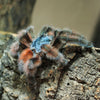The Care and Maintenance of the Brazilian Black Tarantula

Difficulty Level: Beginner
The Brazilian Black Tarantula Grammostola pulchra is a true classic in the tarantula hobby. You will typically see them praised on social media forums for their striking appearance and mellow disposition—both reasons they are such a popular pet tarantula. Grammostola pulchra is a terrestrial New World species that grows slowly but lives a long, rewarding life in captivity. Their deep black coloration, especially vibrant after a fresh molt, has earned it a loyal following among both new and experienced keepers. If you’re looking for a relaxed, low-maintenance tarantula with lasting appeal, the Brazilian Black tarantula is an excellent choice.
Natural History and Description
Grammostola pulchra originates from the border region between Brazil and Uruguay, where it lives in open grasslands and forest edges. Unlike the tropical rainforests associated with South America, these areas are dry and temperate with seasonal rainfall. These tarantulas are opportunistic burrowers, often using natural crevices or abandoned burrows rather than digging extensive tunnels.
Adult females can reach up to 6" in diagonal leg span and live for 25-30 years, while males mature more quickly and rarely live beyond 7 or 8 years in captivity. Unlike some species, Brazilian Blacks are not sexually dimorphic before maturity. Mature males can be identified by their longer legs, slimmer bodies, and the presence of tibial hooks and bulbous pedipalps after their ultimate molt.
Due to strict export laws in Brazil, many so-called "Brazilian Blacks" in the hobby today are imported from Uruguay and may be G. quirogai. Though these species look virtually identical, anyone attempting to breed their tarantulas should avoid pairing individuals of uncertain origin, as they may not be compatible. If you want more information on the pulchra/quirogai mixups, I have made a video on the topic linked below.
Recommended Supplies for a Brazilian Black Tarantula
-
Terra Aranea Bioactive Substrate Kit - Includes Terra Aranea bioactive substrate, leaf litter, and sphagnum moss.
-
Cork Bark - Perfect for hides and structural support.
- Springtails - Excellent bioactive cleanup crew.
- Clippings from plants like peperomia, elephant feed, and jade - suitable for a drier habitat.
-
Botanicals & Seed Pods - Great for decor and enrichment.
-
Bio Dude Acrylic Display Box Medium - Good for juveniles.
-
Bio Dude Acrylic Display Box Large - Great for sub-adults.
-
Tarantula Cribs Enclosures - Excellent options for spiderlings and adults.
-
Solar Grow LED - Ideal lighting for a plant-friendly day/night cycle.
-
Bio Dude Rock Water Dish - Shallow, safe, and easy to clean.
-
Pressure Sprayer Mister - Spot misting tool.
-
Hemostats & Feeding Tongs - For safe prey handling.
Enclosure Size & Setup
Spiderlings
-
Use a small enclosure like a Sling Crib or 3" Tarantula Cube.
- Fill up at least 2/3 of the volume with Terra Aranea.
-
Keep one corner of the substrate slightly damp, and always include a tiny water dish or drip water along the wall weekly. Don’t keep the substrate soggy, but also do not let it completely dry out.
Juveniles
-
Move up to a Bio Dude Acrylic Display Box Medium or a Tarantula Cribs Medium Slider Crib or 8" Cube.
-
Enclosure should be wider than it is tall to reduce fall risks and support terrestrial behaviors.
-
Fill 1/2 to 2/3 of enclosure depth with substrate. Add cork bark and some leaf litter for structure and comfort.
Sub-Adults
-
Upgrade to a Bio Dude Acrylic Display Box Large or Tarantula Cribs Cuboid or 12" Cube.
-
Maintain a similar layout with ample floor space, a reliable hide, and deep substrate.
Adults
-
Ideal enclosures include the Tarantula Cribs Large Slider Crib, 12" Cube, or 18" Cube.
-
Floor space should be 3-5x the tarantula’s diagonal leg span.
Fill the enclosure at least halfway with substrate. Maintain a maximum fall distance no greater than 1.5x the tarantula’s leg span.
Lighting, Heating & Humidity
Lighting: Tarantulas don’t need UVB. However, a Solar Grow LED can help plants thrive and maintain a healthy day/night cycle.
Heating: Aim for ambient temps of 68°F-76°F (20-24°C). Avoid heat lamps or under-tank heaters. If additional heat is necessary, use a thermostat-controlled heat pad on the side of the enclosure.
Humidity: Maintain moderate humidity. Keep the bottom layers of substrate slightly moist, especially for slings. Let the top layers dry between waterings. Overflowing the water bowl once or twice a month is usually enough.
Substrate
Use Terra Aranea as your foundation. Mix in some Leaf Litter and Sphagnum Moss for moisture retention and a natural aesthetic. I like to add the Bio Dude Bio Shot for bioactivity, and introduce springtails to help manage any mold and break down the waste. It is best to avoid using isopods because they may disturb your tarantula during vulnerable periods, like when they are molting.
Decor & Plants
In addition to a water dish, a cork bark hide is essential to their setup. A half round of cork bark a little larger than your tarantulas legspan will make a nice home for their burrow. Just bury it slightly in the substrate, usually a corner works best, and your tarantula will do the rest. You can also decorate with leaf litter, moss and seed pods. Personally I like to sprinkle some Exo Terra Stone Desert on the top of the substrate to provide natural contrast and structure. If you want to add some live plants then small clippings from plants like peperomia, elephant feed, and jade are recommended. You want to avoid any cacti or succulents that have sharp points as they can damage your spider if they were to fall on them. Whatever you decide to plant, be prepared for your G. pulchra to dig it up and climb all over it, so make sure it is hardy and tolerant of low light.
Feeding Schedule
Spiderlings
-
Feed twice weekly with fruit flies, pinhead crickets, or pre-killed roach nymphs.
-
Remove uneaten prey within 24 hours.
-
After Molt: Wait 24-48 hours and ensure fangs are black before feeding.
Juveniles
-
Feed every 7-10 days with small to medium crickets or Dubia roaches.
-
Adjust feeding based on abdomen size. Feed less when the abdomen is wider than the carapace, and feed more if the abdomen is thinner than the carapace.
-
After Molt: Wait 3-7 days before feeding.
Adults
-
Feed every 2-3 weeks with 4-5 large crickets or one large Dubia roach.
-
Monitor abdomen size to prevent obesity. Feed less often when plump and more often when the abdomen is smaller than the carapace.
-
After Molt: Wait 7-14 days before offering food. You will know they are fully hardened when their fangs are black and no longer look clear or white.

Supplements
Tarantulas don’t require calcium or vitamin supplements, but it is very important to gutload your feeder insects with fresh fruits and vegetables 24 hours before feeding.
Temperament
Brazilian Blacks are renowned for their calm, laid-back demeanor and attractive appearance. Adults will often stay out in the open and will rarely flick their hairs unless provoked. This not only makes them a popular pet tarantula, but also a species that many keepers elect to handle. Handling tarantulas is a controversial topic in the hobby and comes with a list of pros and cons. If you would like to learn more about the benefits and risks associated with handling tarantulas as well as information on how to handle your pet tarantula safely, check out my video linked below. Spiderlings may be more shy and will spend the majority of their time hidden deep in their burrow, but tend to grow out of that. Like all tarantulas, individuals can vary in temperament, and a normally docile spider can become defensive after a molt. Always assess behavior before attempting any handling or enclosure maintenance.

Final Thoughts
The Brazilian Black Tarantula (Grammostola pulchra) is an ideal species for anyone looking for a gorgeous, low-maintenance display tarantula. Its long lifespan, calm behavior, and resilience make it a top pick for beginners and a dependable favorite for experienced keepers. While visual similarities to G. quirogai have created confusion in the hobby, supporting captive-bred specimens and verified breeding projects helps maintain sustainable populations. From time to time it can be difficult to locate spiderlings available for sale, and adult Brazilian Black tarantulas can be very expensive. However, as more captive breeding projects are successful, more available and affordable these amazing tarantulas will become.
If you're after a beautiful tarantula with a relaxed personality and impressive longevity, the Brazilian Black Tarantula definitely won’t disappoint.
Written by Richard from Tarantula Collective – 5/14/2025
- Josh Halter









